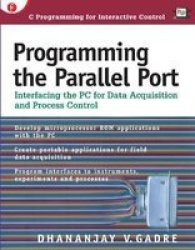Description
This book is about programming the parallel port on a PC to create data acquisition and process control systems. It covers the enhanced parallel port (EPP), the extended capabilities port (ECP), and how to interface analog-to-digital converters.
Why purchase expensive add-on cards or bus interfaces when you can develop effective and economical data acquisition and process controls using C programs? Using the under-employed printer adapter (that is, the parallel port of your PC), you can turn your computer into a powerful tool for developing microprocessor applications. Learn how to build a complete data acquisition system and such varied applications as a CCD camera controller, a photometer interface, and a wave form generator. The book also covers the enhanced parallel port (EPP), the extended capabilities port (ECP), interfacing analog-to-digital converters, and data acquisition under Linux. This extraordinary software approach to interfacing through the parallel port will be especially appealing to programmers involved in control systems design and device development, as well as to those who work with real-time and embedded systems. ;
Key topics include; the Enhanced Parallel Port (EPP), Extended Communications Port (ECP), Analog/Digital Converters (ADC and DAC), adding bits to the parallel port, hosting an EPROM emulator, connecting to an external microprocessor, and generating digital waveforms.
